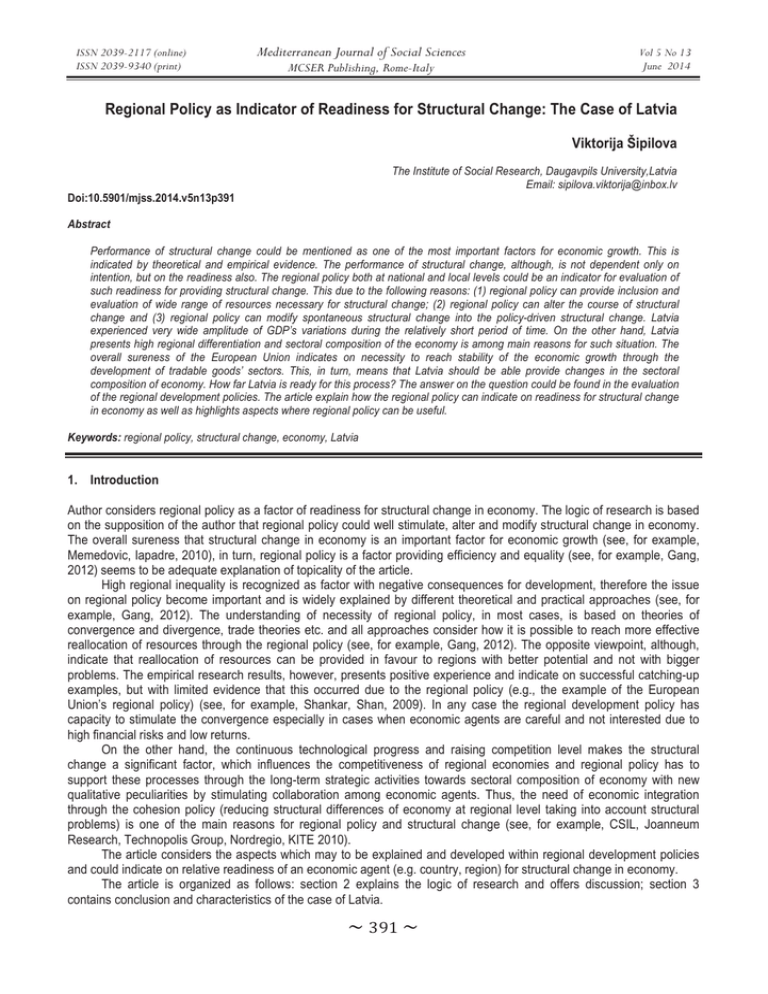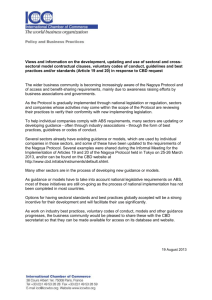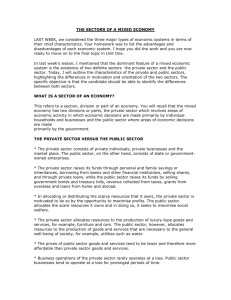Regional Policy as Indicator of Readiness for Structural Change: The Case... Mediterranean Journal of Social Sciences Viktorija Šipilova
advertisement

ISSN 2039-2117 (online) ISSN 2039-9340 (print) Mediterranean Journal of Social Sciences MCSER Publishing, Rome-Italy Vol 5 No 13 June 2014 Regional Policy as Indicator of Readiness for Structural Change: The Case of Latvia Viktorija Šipilova The Institute of Social Research, Daugavpils University,Latvia Email: sipilova.viktorija@inbox.lv Doi:10.5901/mjss.2014.v5n13p391 Abstract Performance of structural change could be mentioned as one of the most important factors for economic growth. This is indicated by theoretical and empirical evidence. The performance of structural change, although, is not dependent only on intention, but on the readiness also. The regional policy both at national and local levels could be an indicator for evaluation of such readiness for providing structural change. This due to the following reasons: (1) regional policy can provide inclusion and evaluation of wide range of resources necessary for structural change; (2) regional policy can alter the course of structural change and (3) regional policy can modify spontaneous structural change into the policy-driven structural change. Latvia experienced very wide amplitude of GDP’s variations during the relatively short period of time. On the other hand, Latvia presents high regional differentiation and sectoral composition of the economy is among main reasons for such situation. The overall sureness of the European Union indicates on necessity to reach stability of the economic growth through the development of tradable goods’ sectors. This, in turn, means that Latvia should be able provide changes in the sectoral composition of economy. How far Latvia is ready for this process? The answer on the question could be found in the evaluation of the regional development policies. The article explain how the regional policy can indicate on readiness for structural change in economy as well as highlights aspects where regional policy can be useful. Keywords: regional policy, structural change, economy, Latvia 1. Introduction Author considers regional policy as a factor of readiness for structural change in economy. The logic of research is based on the supposition of the author that regional policy could well stimulate, alter and modify structural change in economy. The overall sureness that structural change in economy is an important factor for economic growth (see, for example, Memedovic, Iapadre, 2010), in turn, regional policy is a factor providing efficiency and equality (see, for example, Gang, 2012) seems to be adequate explanation of topicality of the article. High regional inequality is recognized as factor with negative consequences for development, therefore the issue on regional policy become important and is widely explained by different theoretical and practical approaches (see, for example, Gang, 2012). The understanding of necessity of regional policy, in most cases, is based on theories of convergence and divergence, trade theories etc. and all approaches consider how it is possible to reach more effective reallocation of resources through the regional policy (see, for example, Gang, 2012). The opposite viewpoint, although, indicate that reallocation of resources can be provided in favour to regions with better potential and not with bigger problems. The empirical research results, however, presents positive experience and indicate on successful catching-up examples, but with limited evidence that this occurred due to the regional policy (e.g., the example of the European Union’s regional policy) (see, for example, Shankar, Shan, 2009). In any case the regional development policy has capacity to stimulate the convergence especially in cases when economic agents are careful and not interested due to high financial risks and low returns. On the other hand, the continuous technological progress and raising competition level makes the structural change a significant factor, which influences the competitiveness of regional economies and regional policy has to support these processes through the long-term strategic activities towards sectoral composition of economy with new qualitative peculiarities by stimulating collaboration among economic agents. Thus, the need of economic integration through the cohesion policy (reducing structural differences of economy at regional level taking into account structural problems) is one of the main reasons for regional policy and structural change (see, for example, CSIL, Joanneum Research, Technopolis Group, Nordregio, KITE 2010). The article considers the aspects which may to be explained and developed within regional development policies and could indicate on relative readiness of an economic agent (e.g. country, region) for structural change in economy. The article is organized as follows: section 2 explains the logic of research and offers discussion; section 3 contains conclusion and characteristics of the case of Latvia. ̱͵ͻͳ̱ ISSN 2039-2117 (online) ISSN 2039-9340 (print) Mediterranean Journal of Social Sciences MCSER Publishing, Rome-Italy Vol 5 No 13 June 2014 2. The Logic of Research and Discussion The section 2 presents author’s intuition and logic of research. Author presents 3 issues where regional development policy could be in a fore of process of structural change in economy: (1) evaluation of resources in context of long-term perspective, (2) altering the course in accordance with resource evaluation, (3) managing and stimulating of activities towards long-term strategic aims. 2.1 Regional Policy Can Provide Inclusion and Evaluation of Wide Range of Resources Necessary for Structural Change in Economy Preconditions for regional competitiveness depend on many factors and the main of them can be organized in the following groups: human resources, financial capital, and innovative potential (see Figure 1). The above mentioned resources are crucial in possible processes of reallocation and combination through the regional development programmes. Figure 1. Distribution of resources among sectors of economic activity Source: elaborated by author based on Doeringer, 1971; Hudson, 2007; European Commission, 2010; Janger et al., 2011; Rusu, 2013; Baier, Kroll, Zenker, 2013; Šipilova, 2014a; Šipilova, 2014b The interests of economic agents can provide differences in perception of sectors of economic activity among economic agents and relative separation of them on two groups as sectors of ‘wellbeing’ concept1 and sectors ‘desirable’ for structural change2 (see Figure 1) 3. Possible mismatch among sectors of ‘wellbeing’ concept and sectors ‘desirable’ for structural change highlights the importance of regional policy in evaluation and distribution of resources, because differences in perception among these sectors can hinder development of smart specialization through effective reallocation of limited resources. Such separation occurs due to relatively fast returns and high possibilities to reach desirable wellbeing both for entrepreneurs and employees within sectors of ‘wellbeing’ concept and results in more active resource flows directed to these sectors. This, although, could be characterized as short-term perspective. In turn, sectors of ‘desirable’ structural change are tended towards long-term period and can be characterized by higher financial risks and longer time needed for returns what in most cases hinder the resource reallocation in favour to these sectors. In other words, regional development policy is one of the main tools for reaching ‘desirable’ structural change in economy through stimulating of interest among economic agents (for example, entrepreneurs and labour force) to direct activities towards sectors ‘desirable’ for structural change, for example, by implementation of development programmes. Sectors of ‘wellbeing’ concept can be characterized as more attractive for labour force, entrepreneurs and capital flows due to positive returns in relatively short period of time and possibilities of career growth 2 Sectors ‘desirable’ for structural change are required by the modern trends in global economy, and are actively put into the development strategies 3 Development of such approach is based on author’s intuition and understanding of labour market’s dualism (Doeringer, 1971; Hudson, 2007) and necessity of smart specialization through the reallocation of resources towards more innovative activities (the strategy “Europe 2020”)(European Commission, 2010). Author mentions this issue in the works Šipilova (2014a; 2014b) also. The theme is developed concerning the linkage among choice of education by potential workforce and changes in sectoral composition of economy. 1 ̱͵ͻʹ̱ ISSN 2039-2117 (online) ISSN 2039-9340 (print) 2.2 Mediterranean Journal of Social Sciences MCSER Publishing, Rome-Italy Vol 5 No 13 June 2014 Regional Policy Can Alter the Course of Structural Change in Economy Structural change in its sense means developing of smart specialization. In turn, smart specialization is considered as a tool for easy moving into the knowledge economy (Rusu 2013; Baier, Kroll, Zenker 2013) what means ‘desirable’ structural change also. The process of reallocation of resources necessary for development of smart specialization through the ‘desirable’ structural change can be hindered by persistent and historically well-founded resource flows. In general, the sectors of ‘wellbeing’ concept can be considered as sectors of regional specialization. The current statement of sectoral composition of economy is related to the historical processes of economic development, specialization developed by the local economy and resources (human resources and financial capital) have been attracted and reallocated (see Figure 2). Altering of the processes of structural change is necessary to avoid regressive structural change and achieve effective reallocation of resources. Moreover, supporting and altering of regional structural change should take into account several opposing aspects which should be managed: (1) concentration towards specialization for saving and developing sectors of ‘wellbeing’ concept, (2) reallocation and concentration of resources for achieving ‘desirable’ structural change, (3) trying to go out of ‘historical’ direction of development towards challenges of the modern economy, (4) identifying innovative potential both among sectors of regional specialization as well as among sectors necessary for progressive structural change in sectoral composition of economy. Figure 2. Input-output of the process of structural change altered by regional development policy Source: elaborated by author based on CSIL, Joanneum Research, Technopolis Group, Nordregio, KITE, 2010; Janger et al., 2011; Rusu, 2013; Baier, Kroll, Zenker, 2013 Regional policy, also, can reach changes in understanding of sectors of ‘wellbeing’ concept and sectors ‘desirable’ for structural change through the stimulation of progressive structural change in economy (e.g. towards gradual but persistent increase of share of high-technology manufacturing or knowledge-intensive services through the regional development programmes). Activities for supporting structural change, although, should not discriminate sectors of specialization as well as sectors which historically had success and provided regional identity. Therefore regional development policy could be an important tool for balancing the historical success and movement towards modern trends. 2.3 Regional Policy Can Modify Spontaneous Structural Change into the Policy-Driven Structural Change Technological progress is one of the main factors which stimulate structural disproportions in the sectoral composition of economy because of several tendencies: (1) cyclical development of sectors of economic activity, (2) changing of accents in the processes of economic growth, (3) changing of priorities in the financial and non-financial investments, (4) changing of preferences of labour market and labour force. Therefore, the main issue asks economic agents to make a choice among two possibilities – to emulate or to innovate (see Figure 3). The lack of resources necessary for being able to follow the technological progress can provide situation when ̱͵ͻ͵̱ ISSN 2039-2117 (online) ISSN 2039-9340 (print) Mediterranean Journal of Social Sciences MCSER Publishing, Rome-Italy Vol 5 No 13 June 2014 economic agents direct their activities towards sectors with relative fast returns and thus stimulating the spontaneous structural change away from high-technology sector. Such spontaneous behaviour of economic agents (the structural change in sectoral composition of economy) could be modified by the regional development policy. Now local economies are welcomed to coordinate concentration towards specialization, locally well identified priorities and diversification of a regional sectoral composition of economy (European Commission 2010; CSIL, Joanneum Research, Technopolis Group, Nordregio, KITE 2010). The success can be dependent on local economy’s ability to emulate and/or realize its innovative potential through the priority investments. Figure 3. Components of regional development policy for managing structural change in economy Source: elaborated by author based on CSIL, Joanneum Research, Technopolis Group, Nordregio, KITE, 2010; Janger et al., 2011, Reinerts, 2012; Rusu, 2013; Baier, Kroll, Zenker, 2013 Moreover, the spontaneous structural change (as degradation of significance of certain sectors of economy or relatively low possibilities to develop high-technology and knowledge-intensive sectors due to lack of resources) can be modified into the policy-driven by setting and supporting of correct priorities and applying of correct tools as emulation and/or development of innovation through setting correct priority investments. 3. Conclusion and Insight into Latvia’s Readiness for Structural Change from the Viewpoint of Regional Policies Author offers to consider regional development policy as a factor of readiness for structural change in economy, what is especially topical during the convergence processes. The article is designed in the framework of possible interaction between regional policy and structural change in economy. Author considers 3 issues of regional policy, as evaluation, altering and managing. The main questions should be asked by applying the regional policies in the process of structural change in economy are as follows: (1) possible mismatch among sectors of ‘wellbeing’ concept and sectors ‘desirable’ for structural change, (2) choice between possibilities to emulate or to innovate, (3) balancing between the historical success and movement towards modern trends. Author concludes that regional policy could be an important tool in the processes of structural change in economy. Regional policy can be crucial in the processes of stimulating, providing and managing the ‘desirable’ structural change by: (1) Improving preconditions of economic environment towards supporting those sectors of economy which are ‘desirable’ for structural change based on detailed evaluation of resources and thus identifying innovative potential, (2) Altering the course of structural change towards requirements of modern economy through changing an understanding of sectors of ‘wellbeing’ concept and sectors ‘desirable’ for structural change by supporting innovative potential of economic sectors; but at the same time by saving regional specialization and regional identity, (3) Modifying of spontaneous structural change into the policy-driven structural change through supporting of processes of emulation and/or realizing of innovative potential by working towards attraction of priority investments. ̱͵ͻͶ̱ ISSN 2039-2117 (online) ISSN 2039-9340 (print) Mediterranean Journal of Social Sciences MCSER Publishing, Rome-Italy Vol 5 No 13 June 2014 Purple colour indicates on the 1st aspect: regional policy can provide inclusion and evaluation of wide range of resources necessary for structural change in economy; green colour indicates the 2nd aspect: regional policy can alter the course of structural change in economy; grey colour indicates the 3rd aspect: regional policy can modify spontaneous structural change into the policy-driven structural change Figure 4. The logic of interaction between regional development policy and structural change in economy Source: elaborated by author based on data (Figure 1, 2, 3) Doeringer, 1971; Hudson, 2007; European Commission, 2010; CSIL, Joanneum Research, Technopolis Group, Nordregio, KITE, 2010; Janger et al., 2011; Reinerts, 2012; Rusu, 2013; Baier, Kroll, Zenker, 2013; Šipilova, 2014a; Šipilova, 2014b Inclusion and implementation of all three aspects within regional policy can indicate on readiness of economic agents to provide structural change because of clearly identified priorities, detailed evaluated resources and rationally understood obstacles for achieving the aims as well as due to correctly applied tools for effective realizing the potential (see Figure 4). 4. Latvia’s Readiness for Structural Change from the Viewpoint of Regional Policies Theoretical and empirical research findings as well as the overall sureness of the European Union indicate on necessity to reach stability of the economic growth and thus convergence also through the development of tradable goods’ sectors and innovative activities (see, for example, European Commission, 2010). This, in turn, means that Latvia should be able provide changes in the sectoral composition of economy towards high-technology and knowledge-intensive sectors of economy due to the following reasons: (1) Latvia experienced very wide amplitude of GDP’s variations during the relatively short period of time, (2) Sectoral composition of economy in Latvia demonstrates dominance of non-tradable sector, especially of those sectors which are oriented on domestic market and have relatively low productivity level comparing with manufacturing, (3) Latvia presents high regional differentiation and sectoral composition of the economy is among main reasons for polarization among capital city region and other regions, (4) In most cases regions specializes in low-technology and labour intensive sectors, as agriculture or services oriented on domestic market. ̱͵ͻͷ̱ ISSN 2039-2117 (online) ISSN 2039-9340 (print) Mediterranean Journal of Social Sciences MCSER Publishing, Rome-Italy Vol 5 No 13 June 2014 How far Latvia is ready for the ‘desirable’ structural change in economy? The answer on the question could be found in the evaluation of the regional development policies in the framework of the logic of this article. Latvia, despite some unfavourable tendencies in sectoral composition of economy, gradually moves towards development of innovative foundations in economic growth through the structural change in the sectoral composition of economy what is indicated both by data on employment and value added (see, for example, Šipilova, 2013; Šipilova 2014c). Although, this process could be more successful in case if regional development policies include all three aspects mentioned above. At this moment, regional development policies in Latvia (Latvijas Republikas Saeima, 2010; Latgales plƗnošanas reƧions, 2010; Kurzemes plƗnošanas reƧions, 2004; RƯgas plƗnošanas reƧions, 2008; Vidzemes plƗnošanas reƧions, 2007; Zemgales plƗnošanas reƧions, 2008) do not provide the answer on the following questions: (1) How to stimulate changes in perception of sectors of ‘wellbeing’ concept and sectors ‘desirable’ for structural change and decrease mismatch among these sectors? (2) Whether all regions in Latvia and country as a whole should understand the ‘desirable’ structural change in the same or different manner taking into account historical development of economy and specialization? Latvia from the viewpoint of regional policies is coming closer to be ready for ‘desirable’ structural change in the sectoral composition of economy, but detailed evaluation, definition and inclusion into regional policies of sectors of ‘wellbeing’ concept and sectors ‘desirable’ for structural change is needed as well as the evaluation of possibilities to emulate or to innovate should be provided. 5. Acknowledgement This work has been supported by the European Social Fund within the project “Support for the implementation of doctoral studies at Daugavpils University, 2nd stage” Agreement Nr. 2012/004/1DP/1.1.2.1.2/11/IPIA/VIAA/011 References Baier, Z., Henning, K., Zenker, A. (2013). Templates of smart specialization: Experiences of place-based regional development strategies in Germany and Austria. Working Papers Firms and Region. No. R5/2013. Retrieved from: http://www.clusterpolisees3 .eu/ClusterpoliSEEPortal/resources/cms/documents/2013.03_Templates_of_smart_specialisation__Experiences_of_Germany_and_Austria.pdf CSIL, Joanneum Research, Technopolis Group, Nordregio, KITE (2010). Contract No. 2008.CE.16.0.AT.020 concerning the ex post evaluation of cohesion policy programmes 2000-2006 co-financed by the European Regional Development Fund (Objectives 1 and 2) Work Package 4 “Structural Change and Globalization.” Final Report. Part 1. Retrieved from: http://ec.europa.eu/regional _policy/sources/docgener/evaluation/pdf/expost2006/wp4_final_report_p1_en.pdf. Doeringer, P.B., Piore, M.J. (1971). Internal Labour Markets and Manpower Analysis. D.C. Heath and Company, Lexington, MA. European Commission. (2010). Europe 2020. Communication form the commission. A strategy for smart, sustainable and inclusive growth. Retrieved from: http://ec.europa.eu/research/era/docs/en/investing-in-research-european-commission-europe-20202010.pdf. Gang, LI. (2012). The Origin of EU Regional Policy in a Theoretical Perspective. Working paper series on European studies. Institute of European studies Chinese academy of Social Sciences. Vol. 6, No. 5, 2012. Retrieved from: http://ies.cass.cn/en/UploadFiles _8765/201212/2012121015050321.pdf. Hudson, K. (2007). The new labor market segmentation: Labor market dualism in the new economy. Social Science Research, 36, 286312. Janger, J. (coordinator), Holzl, W., Kaniovski, S., Kutsam, J., Peneder, M., Reinstaller, A., Sieber, S., Stadler, I., Unterlass, F. (Research Assistance) Guttmann, D., Hranyai, K., Langer, I., Neppl, E., Sokoll, E. (Scientific Advisors) Hollenstein, V., Weresa M. (2011). Structural Change and the Competitiveness of EU Member States. Final Report CR 2011. Retrieved from: http://ec.europa.eu/ enterprise/policies/industrialcompetitiveness/documents/files/structural_change_en.pdf. Kurzemes plƗnošanas reƧions. (2004). Kurzemes plƗnošanas reƧiona attƯstƯbas stratƝƧijas projekts. Retrieved from: http://www.liepaja. lv/upload/Bizness/Attistiba/kurzemes_planoshanas_doc1.pdf. (In Latvian). Latgales plƗnošanas reƧions. (2010). Latgales plƗnošanas regiona attƯstƯbas programma 2010-2017. Retrieved from: www.latgale .lv/lv/files/download?id=1523. (In Latvian). Latvijas Republikas Saeima. (2010). Latvijas ilgtspƝjƯgas attƯstƯbas stratƝƧija lƯdz 2030. gadam. Retrieved from: http://www.liepaja.lv/ upload/attistibas_planosana/lias_2030_10jun2010_saeima_apstiprina.pdf. Memedovic, O., Iapadre, L. (2010). Structural change in the world economy: Main features and trends. Research and Statistics Branch Working Paper, 24. United Nations Industrial Development Organization, Vienna. Retrieved from: http://www.unido.org/ fileadmin/user_media/Publications/Research_and_statistics/Branch_publications/Research_and_Policy/Files/Working_Papers/20 09/WP%2024%20Structural%20Change%20in%20the%20World%20Economy%20- ̱͵ͻ̱ ISSN 2039-2117 (online) ISSN 2039-9340 (print) Mediterranean Journal of Social Sciences MCSER Publishing, Rome-Italy Vol 5 No 13 June 2014 %20Main%20Features%20and%20Trends.pdf. Reinerts E.S. (2012). KƗ bagƗtas valstis kƺuva bagƗtas... un kƗpƝc nabadzƯgas valstis paliek nabadzƯgas. Zvaigzne ABC. (In Latvian). Rigas planosanas regions. (2008). RƯgas plƗnošanas reƧiona attƯstƯbas stratƝƧija 2000-2020. Retrieved from: http://www.rpr.gov.lv /uploads/filedir/RPR%20strat/RPR_Att_strategija_2000_2020.pdf. (In Latvian). Rusu, M. 2013. Smart Specialization a Possible Solution to the New Global Challenges. Procedia Economics and Finance. 6, pp. 128136. Shankar, R., Shan A. (2009). Lessons from European Union policies for regional development. Retrieved from: http://www.wds. worldbank.org/servlet/WDSContentServer/WDSP/IB/2009/06/22/000158349_20090622133035/Rendered/PDF/WPS4977.pdf. Šipilova, V. (2014a). Does Education Contribute to ‘Desirable’ Structural Change in Labour Market in Latvia? Experience of Regional Policy and searching of Innovative Trends. Virtual presentation during the 6th International Conference EDULEARN 2014, Barcelona-Spain, July 7-July 9, 2014. Šipilova, V. (2014b). Education for Structural Change and Innovativeness of the Economy in Latvia. Procedia - Social and Behavioural Studies. INTE 2014. Article accepted for publication. Šipilova, V. (2013). KvantitatƯvais un kvalitatƯvais strukturƗlo izmaiƼu novƝrtƝjums iekšzemes kopproduktƗ LatvijƗ inovatƯvas ekonomikas veidošanas kontekstƗ. The materials if the International Scientific Conference „Social Sciences for Regional Development 2012: Impact of the Financial Capital on the Region’s Economic Competitiveness.” Part III. Economic Issues, pp. 90-102. (In Latvian). Šipilova, V. (2014c). Structural Change and Economic Growth in Latvia. The Example of One Sector. Proceedings in Conference of Informatics and Management Sciences (ICTIC 2014), Volume 3, Issue 1. Accessed June 28, 2014. Vidzemes plƗnošanas reƧions. (2007). Vidzemes plƗnošanas reƧiona attƯštƯbas programma. Retrieved from: www.vidzeme.lv. (In Latvian). Zemgales plƗnošanas reƧions. (2008). Zemgales plƗnošanas reƧiona attƯštƯbas programma 2008-2014. Retrieved from: www.zemgale .lv. (In Latvian). ̱͵ͻ̱




